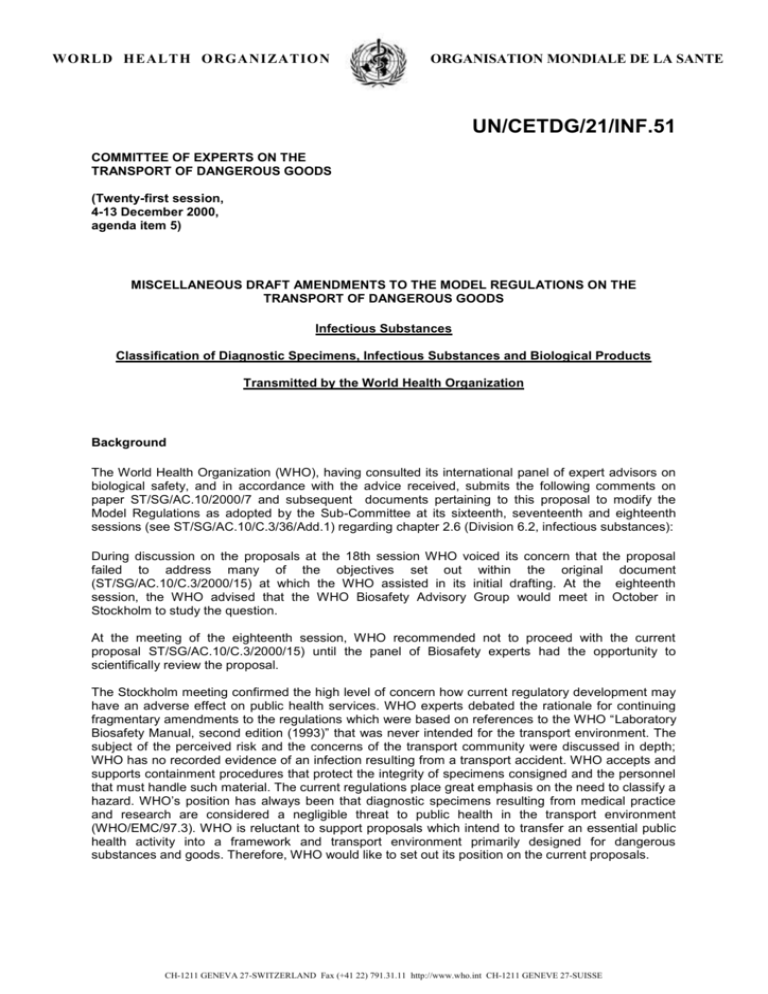Letter - unece
advertisement

WORLD HEALTH ORGANIZATIO N ORGANISATION MONDIALE DE LA SANTE UN/CETDG/21/INF.51 COMMITTEE OF EXPERTS ON THE TRANSPORT OF DANGEROUS GOODS (Twenty-first session, 4-13 December 2000, agenda item 5) MISCELLANEOUS DRAFT AMENDMENTS TO THE MODEL REGULATIONS ON THE TRANSPORT OF DANGEROUS GOODS Infectious Substances Classification of Diagnostic Specimens, Infectious Substances and Biological Products Transmitted by the World Health Organization Background The World Health Organization (WHO), having consulted its international panel of expert advisors on biological safety, and in accordance with the advice received, submits the following comments on paper ST/SG/AC.10/2000/7 and subsequent documents pertaining to this proposal to modify the Model Regulations as adopted by the Sub-Committee at its sixteenth, seventeenth and eighteenth sessions (see ST/SG/AC.10/C.3/36/Add.1) regarding chapter 2.6 (Division 6.2, infectious substances): During discussion on the proposals at the 18th session WHO voiced its concern that the proposal failed to address many of the objectives set out within the original document (ST/SG/AC.10/C.3/2000/15) at which the WHO assisted in its initial drafting. At the eighteenth session, the WHO advised that the WHO Biosafety Advisory Group would meet in October in Stockholm to study the question. At the meeting of the eighteenth session, WHO recommended not to proceed with the current proposal ST/SG/AC.10/C.3/2000/15) until the panel of Biosafety experts had the opportunity to scientifically review the proposal. The Stockholm meeting confirmed the high level of concern how current regulatory development may have an adverse effect on public health services. WHO experts debated the rationale for continuing fragmentary amendments to the regulations which were based on references to the WHO “Laboratory Biosafety Manual, second edition (1993)” that was never intended for the transport environment. The subject of the perceived risk and the concerns of the transport community were discussed in depth; WHO has no recorded evidence of an infection resulting from a transport accident. WHO accepts and supports containment procedures that protect the integrity of specimens consigned and the personnel that must handle such material. The current regulations place great emphasis on the need to classify a hazard. WHO’s position has always been that diagnostic specimens resulting from medical practice and research are considered a negligible threat to public health in the transport environment (WHO/EMC/97.3). WHO is reluctant to support proposals which intend to transfer an essential public health activity into a framework and transport environment primarily designed for dangerous substances and goods. Therefore, WHO would like to set out its position on the current proposals. CH-1211 GENEVA 27-SWITZERLAND Fax (+41 22) 791.31.11 http://www.who.int CH-1211 GENEVE 27-SUISSE page 2 WHO’s Position: 1. 2. The World Health Organization endorses the deletion of any reference to the WHO Risk Groups as they relate to diagnostic specimens. WHO would also like to extend the delinking of risk groups to the definitions of Infectious substances and Biological products. All references to the classification of infectious substances and assignment to risk groups should be deleted from the regulations. The reasons why WHO takes this position are: a) The definitions of these risk groups were developed in the late 1970s so that each country is guided in their own decisions about handling pathogenic organisms in laboratories. Diagnostic specimens were never meant nor considered to be included. b) Each country decides on the allocation of pathogens based on local criteria, e.g. pathogenicity, mode of transmission, availability of effective preventive measures and treatment. Although there is general agreement on many of the extremely contagious pathogens, which would be allocated into Risk Group 4, there is be no global list of agreed-upon risk groups. c) There was never any intention to use risk groups for transport guidelines. d) Diagnostic specimens resulting from medical practice and research are considered a negligible threat to public health (WHO/EMC/97.3) Therefore they do not need to be regulated and considered dangerous goods. WHO does not endorse the current proposal in its current form. WHO does not endorse placing diagnostic specimens into an official UN dangerous goods category with UN number and reference, because: a) b) c) d) The regulatory environment would impede ready access to laboratory services essential to public health. Concerns would arise about the unavailability of appropriate packages. The accreditation or training of health care professionals to meet other provisions connected within the model regulations would not be conceivable. The financial impact to particular sectors of public health services would be huge. 3. WHO is concerned about how current model regulations may be misinterpreted by health care professionals and transport personnel, thus negatively impacting the provision of essential healthcare services. Consequently, WHO would support a general revision of regulations pertaining to the transport of infectious and diagnostic specimens, which includes the deletion of any reference to the Risk Group Classification. ___________ CH-1211 GENEVA 27-SWITZERLAND Telegr.: UNISANTE-GENEVA Telex: 415416 OMS Fax: +41 (22) 791.3111 CH-1211 GENEVE 27-SUISSE Télégr.: UNISANTE-GENEVE








